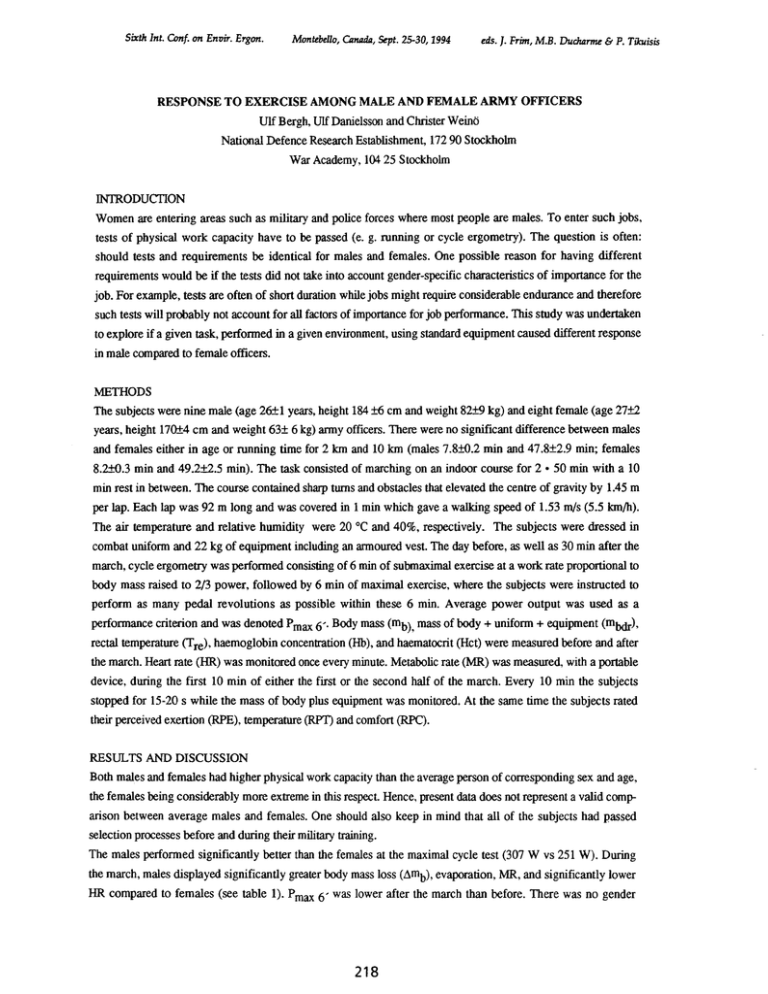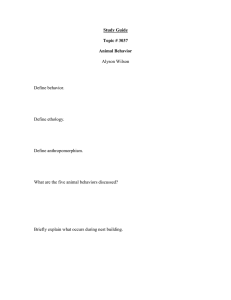RESPONSE TO EXERCISE AMONG MALE AND FEMALE ARMY
advertisement

Sixth Int. Conf. on EnlJir. Ergon. Montebello, OnuuLz, Sept. 25-30, 1994 eds. ]. Frim, M.B. Ducharme & P. Tikuisis RESPONSE TO EXERCISE AMONG MALE AND FEMALE ARMY OFFICERS Ulf Bergh, U1f Danielsson and Christer Weino National Defence Research Establishment, 172 90 Stockholm War Academy, 104 25 Stockholm INIRODUCTION Women are entering areas such as military and police forces where most people are males. To enter such jobs, tests of physical work capacity have to be passed (e. g. running or cycle ergometry). The question is often: should tests and requirements be identical for males and females. One possible reason for having different requirements would be if the tests did not take into account gender-specific characteristics of importance for the job. For example, tests are often of short duration while jobs might require considerable endurance and therefore such tests will probably not account for all factors of importance for job performance. This study was undertaken to explore if a given task, perfonned in a given environment, using standard equipment caused different response in male compared to female officers. METHODS The subjects were nine male (age 26±1 years, height 184 ±6 cm and weight 82±9 kg) and eight female (age 27±1 years, height 170±4 cm and weight 63± 6 kg) army officers. There were no significant difference between males and females either in age or running time for 2 km and 10 km (males 7.8±O.2 min and 47.8±2.9 min; females 8.2±0.3 min and 49.2±2.5 min). The task consisted of marching on an indoor course for 2· 50 min with a 10 min rest in between. The course contained sharp turns and obstacles that elevated the centre of gravity by 1.45 m per lap. Each lap was 92 m long and was covered in 1 min which gave a walking speed of 1.53 mls (5.5 km/h). The air temperature and relative humidity were 20 °C and 40%, respectively. The subjects were dressed in combat uniform and 22 kg of equipment including an armoured vest. The day before, as well as 30 min after the march, cycle ergometry was perfonned consisting of 6 min of submaximal exercise at a work rate proportional to body mass raised to 2/3 power, followed by 6 min of maximal exercise, where the subjects were instructed to perform as many pedal revolutions as possible within these 6 min. Average power output was used as a perfonnance criterion and was denoted P max 6'. Body mass (mb), mass of body + uniform + equipment (mbdr)' rectal temperature (Tre), haemoglobin concentration (Hb), and haematocrit (Hct) were measured before and after the march. Heart rate (HR) was monitored once every minute. Metabolic rate (MR.) was measured, with a portable device, during the first 10 min of either the first or the second half of the march. Every 10 min the subjects stopped for 15-20 s while the mass of body plus equipment was monitored. At the same time the subjects rated their perceived exertion (RPE), temperature (RPT) and comfort (RPC). RESULTS AND DISCUSSION Both males and females had higher physical work capacity than the average person of corresponding sex and age, the females being considerably more extreme in this respect. Hence, present data does not represent a valid comparison between average males and females. One should also keep in mind that all of the subjects had passed selection processes before and during their military training. The males performed significantly better than the females at the maximal cycle test (307 W vs 251 W). During the march, males displayed significantly greater body mass loss (~mb)' evaporation, MR., and significantly lower HR compared to females (see table 1). Pmax 6' was lower after the march than before. There was no gender 218 Sixth Int. Cenf. em En'Dir. Ergon. difference in ~mlY'Ad, ~mbdr/~ Memtebello, Canada, Sept. 25-30, 1994 eds. ]. Frim, M.B. Ducharme & P. Tikuisis and ~m.,;mb' meaning that compensating for differences in body surface area (Ad) eliminated all differences observed between genders. This is different from the findings of Sawka et al. (1983) who found that women had significantly lower sweat rates per unit of surface area. There were, however difference in procedures between these studies, e.g. in the study of Sawka et al the subjects were very lightly dressed and was allowed to drink ad libitum. The magnitude of changes induced by the march in HR., RPE, RPT, RPC. Hb, Hct and P max 6' were not significantly different between genders. Thus, the physical strain of the march did not seem to be different for males as compared to females. The differences observed between genders most likely originated from different body size, mainly body mass. Therefore. the advantage of a lower fluid loss found and lower metabolic rate observed among the female officers should not be interpreted as a gender-specific characteristic. Table 1. Mean values (M) and standard deviations (s) for some of the variables measured in connection with the march. FEMALES MALES VARIABLE M s M s Heart rate (beats • min-I) 138 16 155 Metabolic rate <:W) 657 38 536 7 64 38,3 0,4 38,4 0,3 Rectal temperature (0C) ~body mass (kg) 1,720 0,227 1,237 0,283 ~mass of body + uniform + equip. (kg) 0,939 0,082 0,795 0,159 2,11 0,33 1,95 0,34 14 (~bi'mb)· 100 (%) ~HR march (beats. min -1) ~Tre 7 17 6 0,8 0,5 0,8 0,2 -0,3 3,4 -1 3,3 march (OC) ~ematokrit (%) CONCLUSIONS The differences found between genders were explained primarily by differences in body mass and therefore this study does not support the use of different requirements for male and females in tests of physical endurance capacity. REFERENCE Sawka M., M. Toner, R. Francesconi, and K. Pandolfo 1983. Hypohydration and exercise: effects of heat acclimation, gender, and environment. J. Appl. Physio!.: Respirat. Environ. Exercise Physiol. 55(4): 1147-1153 ACKNOWLEDGEMENTS The authors are indebted to J. Keinanen, B. StAhl, G. Larsson. A. Mikiver, M. Mikiver, E. Malm, and S. Grarnbo for skilful technical assistance. 219



